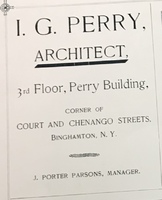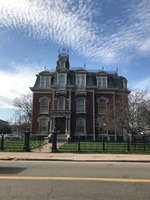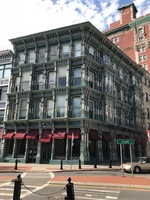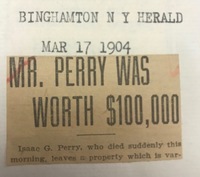Isaac Perry and Binghamton's Golden Age
by Katherine Smalley
How does Isaac Perry's success during the second half of the nineteenth century reflect the wealth in Binghamton at the time?
Isaac Perry was considered Binghamton’s master architect during the city’s golden age.
His success can be closely identified with the economic growth of Binghamton in the second half of the nineteenth century. He designed all kinds of buildings; residential, commercial, ecclesial, and institutional, and the one thing they all had in common was their grandeur. Isaac Perry made a career as an architect of buildings that showcased opulent wealth, built for those that had attained it. The fact that he had so much success doing so in Binghamton is a mark of how much economic growth the city experienced in the second half of the nineteenth century.
Perry was living and working in the heart of Manhattan where he had his own architectural practice when he was called to Binghamton, New York. He moved here after winning the competition to design the New York State Inebriate Asylum, the first institution of its kind. The main building of the asylum was so large and so grand that it is no surprise it came to be known as the “castle on the hill” This project introduced him to the city’s wealthiest residents and showed everyone just how impressive his buildings could be.
The timing of Perry’s arrival was integral his success. Binghamton saw rapid economic growth similar to that of other cities in the northeast during the Gilded Age. The growth of the railroad, shoe, and cigar industries in the area during the second half of the nineteenth century contributed development of Binghamton. The railroad system connected Binghamton to the rest of the United States, which facilitated the influx of people looking for work. The capital brought into the city through these industries created opportunity. The ample opportunity present in Binghamton included the opportunity for an architect such as Isaac Perry to literally build the city itself. The architecture of that period reflected the wealth that was flowing through Binghamton. Perry’s buildings were sensibly planned and well constructed. He built in the popular architectural styles of the Gilded Age; these styles included Second Empire, Gothic, Italianate, Victorian, and Romanesque.
An example of the Isaac Perry’s cliental is Sherman Phelps. Sherman Phelps was a judge, mayor and successful capitalist; in other words, a wealthy and powerful man. Phelps was the fifth mayor of Binghamton, the owner of the Binghamton Gas Light Company, an incorporator of Binghamton Water Works, and the president of a bank known as Susquehanna Bank or Phelps Bank. Sherman Phelps contributed greatly to the rapid financial growth of Binghamton during his time here.
In 1870, Phelps hired Isaac G. Perry to build his mansion, the biggest in the city at the time, and exceedingly lavish at that. The house cost one hundred thousand dollars to build at the time and the staircase alone cost ten thousand dollars. The Sherman Phelps mansion represents the way the elite lived. It still stands today and is now a museum which visitors can view a piece of Binghamton during the Gilded Age.
During his successful career designing and constructing buildings for those that could afford the work he did, Perry made a fortune for himself. He designed one of the most ornate buildings Binghamton has ever seen and had the top floors of it for his very own apartments and office. The building had a cast-iron face and was the only one of its kind in the city. The Perry Block served not only as his living and working spaced but also as an advertisement for what Perry could accomplish as an architect. Built in 1876, the structure was extravagant and another example of “Gilded Age exuberance”.
State Capitol Building
Year built: 1883
Architectural style: Romanesque
In 1883, Perry was appointed as the architect who would complete the State Capitol Building. This is where he designed the famous “million dollar staircase”. He would not have been asked to carry out such an important project if he had not proven he could do it through his past projects. This demonstrates the influence Perry had during his lifetime. When Perry died, he left, along with a large estate he acquired during his career, enduring monuments of his work all over Binghamton and the rest of New York.
Bibliography
“Arrangements for Funeral of Mr. Perry.” Binghamton NY Leader, March 18, 1904.
Boyd, Joel. “Isaac Perry: Looking Back.” The Preservation Association of the Southern Tier. Isaac G. Perry Workshop and Tour. April 16 -17, 1993.
“Death of I. G. Perry.” Binghamton NY Republican, March 18, 1904.
Gitlitz, Michael. “Isaac G. Perry’s Perry Building: Cast Iron Architecture in Binghamton’s Golden Age.” Oberlin College. April 15, 1990.
“A Great Man Gone. A Review of the Active Career of the Late Isaac G. Perry.” Binghamton NY Leader, March 21, 1904.
Grey, Gene. “Monday Afternoon Club to restore Phelps Mansion to its former glory.” Living. October 18, 1997
Haynes, Wesley. “Isaac Perry, Craftsman-Architect.” Adirondack Architectural Heritage Newsletter Volume 9 No. 1 (2000):1-4.
“Isaac G. Perry.” Binghamton NY Leader, March 17, 1904.
“Library Trustees’ Tribute to Mr. Perry’s Memory.” Binghamton NY Leader, March 18, 1904.
“Mr. Perry was Worth $100,000.” Binghamton NY Herald, March 17, 1904.
“The Phelps Mansion.” The Phelps Mansion Foundation. 1993. http//www.tiernet/phelps.
Platt, Frederick. Gilded Age: Its Architecture and Decoration. South Brunswick: A.S Barnes, 1976.
Ryan, James Gilbert. Historical Dictionary of the Gilded Age. Armonk, NY: M.E. Sharpe, 2003.
Smith, Gerald R. The Valley of Opportunity: A Pictorial History of the Greater Binghamton Area. Norfolk, VA: Donning Co., 1988.




